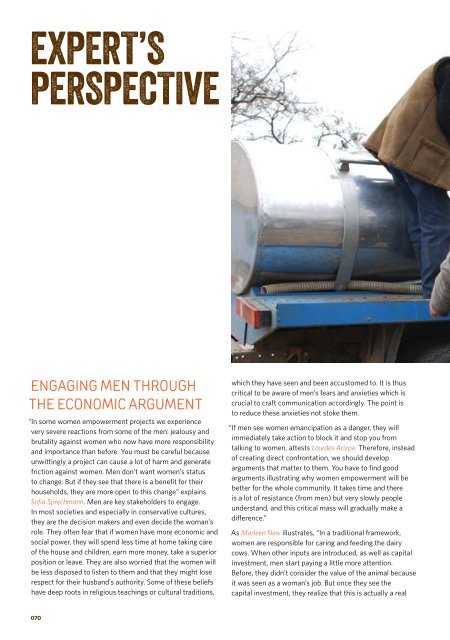EMPOWERMENT
DanoneWomenEmpowerment
DanoneWomenEmpowerment
Create successful ePaper yourself
Turn your PDF publications into a flip-book with our unique Google optimized e-Paper software.
EXPERT’S<br />
PERSPECTIVE<br />
ENGAGING MEN THROUGH<br />
THE ECONOMIC ARGUMENT<br />
“In some women empowerment projects we experience<br />
very severe reactions from some of the men: jealousy and<br />
brutality against women who now have more responsibility<br />
and importance than before. You must be careful because<br />
unwittingly a project can cause a lot of harm and generate<br />
friction against women. Men don’t want women’s status<br />
to change. But if they see that there is a benefit for their<br />
households, they are more open to this change” explains<br />
Sofia Sprechmann. Men are key stakeholders to engage.<br />
In most societies and especially in conservative cultures,<br />
they are the decision makers and even decide the woman’s<br />
role. They often fear that if women have more economic and<br />
social power, they will spend less time at home taking care<br />
of the house and children, earn more money, take a superior<br />
position or leave. They are also worried that the women will<br />
be less disposed to listen to them and that they might lose<br />
respect for their husband’s authority. Some of these beliefs<br />
have deep roots in religious teachings or cultural traditions,<br />
which they have seen and been accustomed to. It is thus<br />
critical to be aware of men’s fears and anxieties which is<br />
crucial to craft communication accordingly. The point is<br />
to reduce these anxieties not stoke them.<br />
“If men see women emancipation as a danger, they will<br />
immediately take action to block it and stop you from<br />
talking to women, attests Lourdes Arizpe. Therefore, instead<br />
of creating direct confrontation, we should develop<br />
arguments that matter to them. You have to find good<br />
arguments illustrating why women empowerment will be<br />
better for the whole community. It takes time and there<br />
is a lot of resistance (from men) but very slowly people<br />
understand, and this critical mass will gradually make a<br />
difference.”<br />
As Marleen New illustrates, “In a traditional framework,<br />
women are responsible for caring and feeding the dairy<br />
cows. When other inputs are introduced, as well as capital<br />
investment, men start paying a little more attention.<br />
Before, they didn’t consider the value of the animal because<br />
it was seen as a woman’s job. But once they see the<br />
capital investment, they realize that this is actually a real<br />
business!” Anatoliy Shatkovskyy confirms: “In our project<br />
area, women are usually responsible for animal farming in<br />
their households. They take care of the cows and milk them.<br />
But today things are changing. As men begin to realize<br />
the potential of dairy farming and when they understand<br />
that it makes economic sense, they begin expanding the<br />
work of their family farms. Sometimes empowerment can<br />
simply be balancing the workload within the family while<br />
simultaneously increasing the income for the household.”<br />
Engaging men and women are complimentary actions<br />
and should be undertaken simultaneously. To engage men<br />
as partners, we suggest two approaches. Lourdes Arizpe<br />
summarizes the first one very well: “Working with men is<br />
not your role… It is the woman’s! We have to convince<br />
men but I’m not sure that the person who does this<br />
should come from outside. This role has to be played by<br />
women themselves and you have to give them very strong<br />
arguments as to why greater participation will benefit the<br />
whole family and community, including men.<br />
Don’t push women but if the preliminary work of<br />
raising critical thinking has been activated, women will<br />
spontaneously try to convince the men by explaining to<br />
them that their greater participation makes economic sense.<br />
The second approach is to work directly with men. Present<br />
the project to them and reassure them about their social<br />
and economic position: “If men have a feeling that there is<br />
a threat to their own power, then you are losing them. The<br />
economic win-win is the most convincing argument. You<br />
have to explain to them in very simple ways and pragmatic<br />
terms and take examples of other communities when the<br />
empowerment of women brought wealth and economic<br />
growth” explains Nayé Bathily. As Maria Nowak confirms,<br />
Give women the means to independence, never appeal to<br />
men! However, greater participation will be better accepted<br />
if the economic argument is put forward.<br />
“The most important thing to remember is to never pitch<br />
men against women. It’s not women against men. It is<br />
women for communities.” concludes Iman Bibars. Always<br />
remember that men are your key allies in the journey<br />
towards greater gender equality. This battle cannot be won<br />
without them.<br />
070 071


